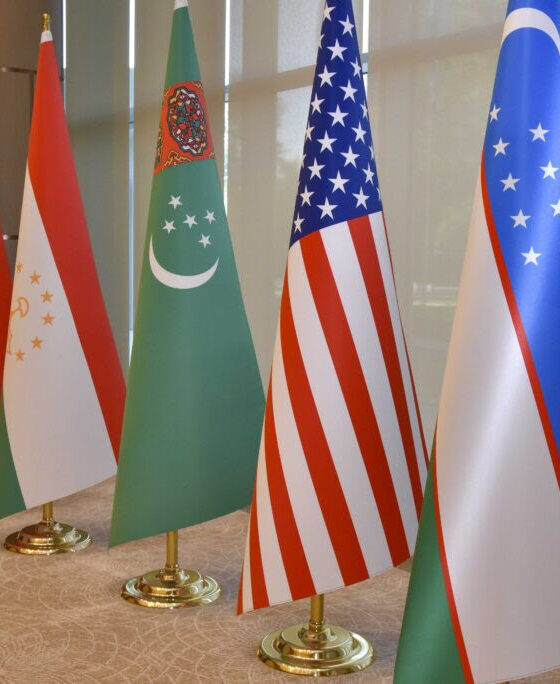By Rafael Sattarov
On March 1, 2017
The recent visit of Vladimir Putin to the countries of Central Asia prompted a mass of material in the local press, headlines that asked the widest range of questions: what is Putin looking for in Central Asia? Is he trying to strengthen his position or is Russia losing Central Asia? One headline even called Putin’s trip an “inspection” of the region. As it turned out, however, it would be a stretch to call Putin’s trip a “regional tour” – he officially visited three countries in the region, and as a result no significant documents were signed changing relations in any way. Rather, the trip was completed in the spirit of celebrating 25 years of diplomatic relations between Russia and the republics of Central Asia, and only confirmed “the high level of mutual political trust.”
Nevertheless, within Russia there are debates about what the policy on this region should look like.
Central for Russia?
If we look at the background of relations between Russia and the countries of Central Asia immediately following the fall of the Soviet Union, we will discover that from the beginning Russian politicians tried to get rid of this region, considering it “excess weight” that was interfering with the country’s shift to the West. It is enough to recall the Yeltsin leadership’s struggle for international credit; Boris Yeltsin agreed to a course of rapid disintegration in order to receive such credit. In 1991, Washington made a deal to offer the credit to the Soviet Union if they could address the following issues: not to allow barriers between the republics of the USSR; to stimulate the process in the republics of the union to work up their own plans for the transition to a market economy; and to form a common fund for repaying the debts of the Soviet Union where each republic must contribute a proportional amount of money. Sergei Shenin, author of the book Return to Russia: Strategy and Policy of American Aid (1990s), wrote: “On October 28, 1991, Boris Yeltsin in his keynote address offered the republics a similarly hard-line framework and conditions for economic cooperation, where it was clear that none of the republics would support the offer.” Yeltsin’s October offer, as is well known, was not accepted by the republics, and the group of Russian liberals and proponents of “shock therapy” were trying to convince Yeltsin that Moscow should with all its strength stand apart from the non-Russian republics of Central Asia, since they were “too backward for radical market reforms and blowing up the anticipated aid on their behalf could put the whole project at risk.”
The situation began to change after 1999 when the Russian leadership, after the bombing of Belgrade and Primakov’s famous pivot over the Atlantic, began to pay more attention to post-Soviet countries.
Under Vladimir Putin, Russia’s Central Asia policy focused on three big fish: the question of security and cooperation in the sphere of MTC (Military-Technical Cooperation, from the modernization of the armed forces of the countries of the region to the construction military bases in Kyrgyzstan and Tajikistan); energy projects in the oil, gas and hydroelectric spheres; and the increased integration of institutions into the Eurasian Economic Union (EEU).
Is Central Asia central for Russia? Experts of Russia’s Council on Foreign and Defense Policy think that “the post-Soviet space needs to be filed away in the archive.” Arguing that “in the modern world it is unnecessary (or even openly disadvantageous) to take on the kind of burden that the Russian tsars and communists did,” the authors of the paper claim that integration with the countries of the former USSR has its limits. An allied state, the Collective Security Treaty Organization (CSTO), or the Eurasian Economic Union, possibly expanded to include one or two more countries, is, likely, the maximum necessary for integration in the near future. These unions need to be filled with concrete content, incorporated into a broader (Eurasian) political-economic configuration.
But not all Russian experts are ready to join such a call. “In all official doctrinal documents of the Russian Federation, Central Asia stands as one of the priorities,” says Stanislav Pritchin, an expert with the Center for the Study of Central Asia and the Caucasus Institute of Oriental Studies of the Russian Academy of Sciences, in an interview. But he agrees that, “in spite of the fact that there are enough international alliances, not all countries of the region are partners in these projects. Therefore, Moscow needs to organize a variable speed strategy in its policy for Central Asia.”
Arkadii Dubnov, an expert on the countries of the CIS, thinks that 25 years after the fall of the USSR, it has become clear that each Central Asian country has its own development path. The Russian leadership’s mistake, he suggests, is that it tries to reduce the relationship to a common denominator, which today takes the form of the EEU. In the course of the visit to Tajikistan, this question could have turned out to be central. “But is it necessary to persuade Dushanbe so insistently to join the EEU considering the lack of success marked by having Kyrgyzstan and Armenia in the union?” asks Dubnov in a conversation at the CAA Network. As a Russian expert notes, the Russian president visits regions where Moscow’s interests are obvious. It would be a mistake to perceive Central Asia as a single region, a fact the Russian ruling elite often demonstrates.
The Common Denominator: Economy or Security?
A favorable tool for “holding neighboring countries in Russia’s orbit” today is Russia’s successful economic development. But economic relations between Russia and Central Asia remain limited to the old principle of “goods in exchange for labor.” Central Asia provides a market for Russian goods, and in exchange Russia provides a labor market for migrants. Economic relations with China, for example, have a great novelty and spark, calling to life various transportation, logistics, and transit projects throughout the region.
For Russia, maintaining allied relationships with the countries of Central Asia has its price. Subsidies, trade preferences, investment, and direct credit, and indirect financing (by allowing migrant laborers and compromise in the transport of hydrocarbons) – this scope of economic relations makes the countries of Central Asia altogether complex partners and places a burden on the Russian budget.
Released at the end of last year, the report “From Turkestan to Central Asia: The Political Future of the Region,” written by Russian and Kazakh analysts, recommends that Russia rethink the existing mechanisms and institutions to correspond to the threat environment, the spirit of the times, and the peculiarities of the region, with the help of which Russia could exert significant influence on the socio-economic development of the countries of the region to provide for their stable development. “Being in a state of permanent socio-economic crisis, and even descending into chaos, Central Asia in any turn of events will exert a negative influence on both Russian and China,” states the report.
The experts repeat the tired thesis that the unstable and poor economies of Central Asia present a risk, namely that Islamic radicals could come to power here and the loyal old regime fall under the weight of the “nationalist agenda.” “How should the Collective Security Treaty Organization act in the event of a repeat of the above-mentioned situations or the emergence of a ‘Central Asian Maidan’?” As such, write the analysts, it is necessary to examine the prospects for broadening possibilities for the Treaty Organization in collective security and dynamic implementation of collective rapid response forces.
Russia’s commitment to defending local authoritarian regimes can play against its interests with the younger generation. What’s more, since Crimea, Russia has been increasingly suspected of excess interference. Russia began to be openly feared, and these concerns pushed the countries to search for a new security plan. Although the American C5+1 and China’s “One Belt, One Road” are far from presenting a guarantee of security, a new strictly regional initiative can be created with the countries of Central Asia in response to the new challenges. Uzbek president Shavkat Mirziyoyev’s visit to Kazakhstan in April 2017 is expected to activate a regional signal. But Arkadii Dubnov is skeptical about the possible visit of Mirziyoyev to Kazakhstan: “It’s not worth assigning much meaning to Mirziyoyev’s first trip abroad, namely to Kazakhstan, if we consider the central place of relations with neighbors in the foreign policy conception of Uzbekistan. What’s more, the coming together of Astana and Tashkent began almost a year ago under Karimov. But just the same, it’s not worth drawing the conclusion that ahead lies a new policy and the reincarnation of some sort of Central Asian union; as stressed above, the region has ceased to be a single unit even in the eyes of the countries of the region themselves. Bilateral relations take on more significance, especially in the era of the growth of national self-identity of the states, not allowing the possibility of losing part of their national authority in the case of a developing integrative alliance,” says Dubnov.
Is the Future of Central Asia Really in the Hands of Russia?
This question in particular was discussed at an event at MGU, with Vladimir Yakunin acting as moderator, the previous head of the Russian Railways and current Assistant Chair of the Department of Political Science at Lomonosov Moscow State University, who said, “We have a united platform, and that is our common Soviet past. Still common for the time being. But mushiness over building the ideal socialism ended at the turn of the 1960s and 70s… There should be a clear doctrinal position that should concern, among other things, the conducting of business.”
With the changing picture of the region, when Russia has already lost its monopoly positions due to the growing economic strength of China, it is possible that the time has come for a more discriminating approach by Russia to the countries of the region, and for calibrated cooperation. This is exactly what the experts from the Council on Foreign and Defense Policy had in mind when they recommended that the Russian leadership leave the post-Soviet space in the past: “Twenty-five years have passed since the fall of the USSR. It is useless to perpetuate nostalgia. A new policy is needed.” As concerns Central Asia, that can mean an especially close level of cooperation with three countries, Russia’s allies in the Eurasian Economic Union and the Collective Security Treaty Organization (Kazakhstan, Kyrgyzstan, and Tajikistan). Uzbekistan and Turkmenistan are “minimal expenditure” partners.
Furthermore, Russia still exercises significant cultural influence over the region, its soft power and mass media influence is at its peak, and local powers readily copy certain Russian laws directed at the preservation of traditionalism and opposition to liberal values.
In all likelihood, the essence of Russian foreign policy in Central Asia is a subject that will be further debated in the Russian expert community. They are, however, also preoccupied with the direction of US foreign policy in Central Asia under President Trump. “The fact that the administration of the American president Donald Trump hasn’t worked out a clear approach either toward Russia or toward Central Asia leaves all regional leaders to worry,” said expert Andrei Grozin to Gazeta.ru. The new administration of President Trump still has yet to significantly address the rethinking of its foreign policy goals, let alone in the less important Central Asian region, where they will also be faced with a restart of the previous two approaches.













